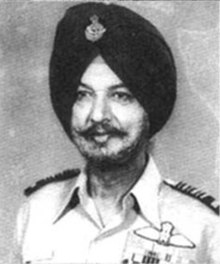Dilbagh Singh
Air Chief Marshal Dilbagh Singh | |
|---|---|
 | |
| Born | 10 March 1926 Rahon Jalandhar district Punjab |
| Died | 9 February 2001 (aged 74) Dehradun, Uttarakhand, India |
| Allegiance | |
| Service/ | |
| Years of service | 1945-1984 |
| Rank | Air Chief Marshal |
| Unit | No. 1 Squadron |
| Commands held | Eastern Air Command Ambala Air Force Station 28 Squadron[1] |
Air Chief Marshal Dilbagh Singh, PVSM, AVSM, VM (10 March 1926 – 9 February 2001) was the head of the Indian Air Force from 1981 to 1984,[2] as Chief of the Air Staff. He was the second Sikh to hold that position.
Dilbagh Singh was commissioned as a pilot in 1944.[3] His operational flying career spanned the Spitfire to introducing the MiG-21 into service in India. He had earlier made the first official "Supersonic Bang" over India in New Delhi when the Mystere IV-A was showcased in a public demonstration.
He was India's Ambassador to Brazil from 1985 to 1987. He was a student of pandit Buta Ram of Rahon. His visit to Rahon to visit his teacher when he was Air Marshal is still remembered. He inspired scores of youngsters from Rahon and Nawanshahar region to join defense forces
References[]
- ^ "Air Marshal Kumaria Visits Air Force Station Chandigarh To Felicitate its 50 Golden Years". 1 March 2011.
- ^ "Dilbagh Singh". Bharat Rakshak. Retrieved 8 April 2018.
- ^ "rediff.com: Air Chief Marshal Dilbagh Singh no more". www.rediff.com. Retrieved 28 May 2020.
External links[]
- Indian aviators
- Chiefs of Air Staff (India)
- Indian Air Force air marshals
- 1926 births
- 2001 deaths
- Indian Sikhs
- Military personnel from Punjab, India
- Ambassadors of India to Brazil
- Recipients of the Param Vishisht Seva Medal
- Recipients of the Ati Vishisht Seva Medal
- Indian Air Force officers
- Alumni of the National Defence College, India
- Indian military personnel stubs
